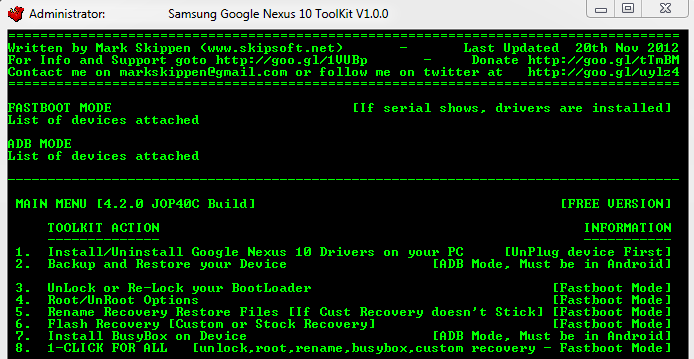AIO or all-in-one toolkits provide a great one-stop solution to perform various activities and modifications on an Android device, such as rooting, installing custom recoveries, unlocking the bootloader et al without the need to use hacks from a lot of different places and sources. XDA Elite Recognized Developer mskip, who is well known for bringing all-in-one toolkits for different devices such as the Galaxy Nexus, Galaxy S3 LTE as well as the Nexus 7, has now released a Toolkit for the recently launched Nexus 10 tablet.
Like all of the other toolkits released by mskip in the, this one for the Nexus 10 also includes an exhaustive list of features, notable ones of which, are listed below:
- Install correct adb/fastboot drivers automatically
- Unlocking/Relocking of the bootloader
- Rooting and Unrooting
- Flashing custom recovery images
- 1-Click For All to Unlock the Bootloader, Root, Rename the Restore File and Flash Custom Recovery
- Nandroid Backups
- Install a single apk or multiple apk’s to your phone
…and a lot more. Easily a must-have tool if you own a Nexus 10. And as always we have put together a short guide on how you can install and use the Nexus 10 toolkit.
How to Install and Use Nexus 10 Toolkit
- Download the Nexus 10 Toolkit to your PC, from the official source page.
- Double click the downloaded file, to start installing the Toolkit on your Windows PC.
- Keep clicking the Next button in the setup wizard. Leave all options as default.
- Once installation is completed, you can launch the Nexus 10 Toolkit by double clicking the icon on your desktop.
- At launch, type in No and then press the Enter button to pull up the Main Menu.
- You will see an exhaustive list of actions that you can perform. To select an action, simply type in the corresponding number at the prompt and press Enter. For e.g If you want to Root your Nexus 10, you need to type the number 4 and press enter
- Once you have entered an action that you want to perform, all you need to do is simply follow the on-screen instructions for next steps.













Discussion